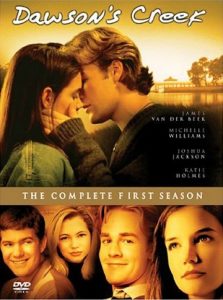The most entertainment-oriented aspect of my Thanksgiving trip to North Carolina was a visit to Wilmington, which to me is defined as “the town where ‘Dawson’s Creek’ was filmed.” In reality, the rich entertainment scene of Wilmington (a beautiful riverfront town for people who love scenery and history, as well) is not defined by “Dawson’s Creek,” or by any single production.
A town of just over 100,000, Wilmington’s status as a mini-Hollywood of the East dates back to the opening of the EUE Screen Gems Studio and the Drew Barrymore movie “Firestarter” in 1984. Hundreds of productions have filmed there since, so although “Dawson’s Creek” is arguably the most famous Wilmington TV show (“One Tree Hill” — which is at nine seasons and counting, compared to six for “DC” — has a loyal fan base too), the relationship between Wilmington and “DC” is comfortable, casual, and not at all commercialized.
At the visitor’s center, there aren’t any brochures for “DC” sites; rather, I asked the attendant if she had any “DC” materials and indeed she did — hidden behind the counter, just a basic FAQ sheet with a dozen or so key addresses. At Hell’s Kitchen, a real bar/restaurant borne out of the fake bar/restaurant from the final season (which I have never watched, except for the finale), Joey’s rowboat is on the wall, but it has no signage to indicate its significance. Although the whole place is a “DC” shrine in the sense that it hasn’t been altered from how it looked on TV, there is no show-specific memorabilia on the walls other than the boat. “Joshua” was carved into the table that I sat at, but if it’s Joshua Jackson’s carving, I’m sure no one there could tell me.
Many “DC” scenes were filmed along the Cape Fear riverwalk, so a die-hard fan could stroll along the waterfront and see, for example, Pacey and Andie’s first kiss in their mind’s eye. But the historical plaques, of course, refer to Wilmington’s rich history as a Southern port. I also swung into Thalian Hall (the Rialto, to “DC” fans), where pivotal Dawson-Joey-Jen love triangle scenes were shot, and again, there’s nothing there that references the show — after all, this is the oldest theater in continuous use in the whole country; a couple of “DC” scenes are a blip on its historical radar.
A quick perusal of the web shows that plenty of serious fans have sought out Dawson’s house, Jen’s house and other privately owned landmarks from the show. I didn’t really have any desire to go that far, nor do I think it’s entirely appropriate to track down non-public locations. Just being in Wilmington is enough to soak up the Capeside vibe, and to be honest, the fact that the “DC” connection is not overtly hyped up made the experience even cooler. I didn’t feel like a crass tourist, as one might feel in a town that’s only known for one historical thing — Cooperstown, N.Y., for example, since I’m drawing a blank on TV examples.

Another neat thing about Wilmington/Capeside is that it’s about as real of a place as a TV location can get. Stars’ Hollow, Conn., might be a prettier place, and Sunnydale, Calif., might make more of an emotional connection with me, but those towns were entirely created on sets and back lots; with a few location-shoot exceptions, they don’t exist outside of our DVD collections. And while an “X-Files” fan could have fun seeking out locations in Vancouver, that’s not quite the same either, because Vancouver was always a stand-in for various U.S. places. “DC” wasn’t technically set in Wilmington, but it feels like it was: Capeside (I’ll never understand why it’s located in Massachusetts instead of North Carolina, but whatever) is based on creator Kevin Williamson’s hometown of New Bern, not far from Wilmington. Williamson (himself the basis for Dawson) had a creek and a ladder that his female friend (the inspiration for Joey) would ascend into his room.
That’s why Joey’s rowboat is more special than Season 6’s Hell’s Kitchen, and why it makes me want to rewatch Season 1 of “DC.” (I’ll definitely get to it on my “Rewatching the classics” project at some point, although I’m not sure if I’ll tackle the later seasons since no definitive versions are available on DVD — Seasons 2 through 6 are victims of the production not paying music rights for DVD use, so those discs are an unfortunate hodgepodge of replacement music and missing scenes. Other than “Beverly Hills, 90210,” there isn’t a show that’s been more mistreated on DVD than “DC.”)
As much as “Dawson’s Creek” was known for its postmodern pop-culture references, the idea of a creek, a rowboat and a ladder to a Spielberg-poster-covered bedroom is timeless and genuine. The show got soapier as it went on (to give you an idea of the dramatic decline: Season 1 is one of my all-time favorite TV seasons, and yet I stopped taping it for posterity after Season 2 and I stopped watching it entirely when Andie departed seven episodes into Season 4), but at the beginning, it was the heartfelt realism that connected with me and millions of other viewers.
It’s wonderful to know that place, that time, that feeling, can be visited in the real world, and not just on DVD.

